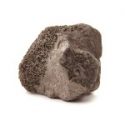It’s raining diamonds! Back in 2008, scientists discovered a meteorite that was hurtling towards Earth. They named it the Almahata Sitta meteorite, and soon after it was discovered and tracked by scientists, it fell to Earth’s surface and exploded into pieces above the Nubian Desert in Sudan.
Since scientists were expecting the meteorite to hit the surface, those who studied meteorites were awaiting its arrival anxiously, and rushed to the crash site as soon as it impacted the surface of our planet. Soon after these scientists began poking and prodding the thing, they discovered that it contained very large diamonds.
Now, that’s actually fairly common: some kinds of meteorites may contain small diamonds that were formed throughout the lifespan of the meteorite as it hurtled through space and ran into other asteroids. The force of such an impact is enough to shock carbon into tiny diamonds.
But the diamonds that scientists discovered in the Almahata Sitta meteorite were large; larger, in fact, than diamonds that could have formed in a meteorite. A recent study suggests that the Almahata Sitta meteorite was likely a fragment of a larger rock, perhaps a bit smaller than a planet, that existed back when our solar system was formed. In the 4.6 billion years since the solar system’s birth, the large rock fragment that contained this particular meteorite has since been blown apart, and some of its sparkly remnants have ended up in a desert in the Sudan.
Cool, right? Now, if only we could engineer these meteorites so that diamonds fall to Earth in a nice princess cut with a gorgeous platinum setting.
Stay tuned for more updates from the premier purveyor of fine jewelry in New York City since 1905 – Frank Pollak & Sons

